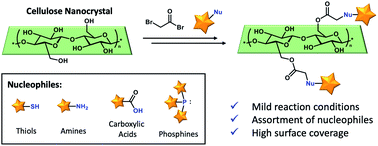Modification of cellulose nanocrystal surface chemistry with diverse nucleophiles for materials integration†
Abstract
As environmental concerns increase, the interest in using renewable sources for the creation of new materials also grows larger. Cellulose nanocrystals (CNCs) are an abundant feedstock that is rapidly rising in popularity to address these challenges. Light-weight and reinforced materials can be obtained through the integration of CNCs, but the field of nanocellulose lacks robust methods to modify the hydrophilic surface chemistry. To increase the utility of these renewable materials, a versatile strategy to modify CNC surfaces is presented that enables a wide range of molecules to be attached through straightforward nucleophilic substitution reactions. CNCs are first modified to introduce electrophilic α-bromoesters to the surface which allows nucleophilic displacement by a wide range of molecules that vary in hydrophobicity, functionality, and complexity. The versatility of this approach is demonstrated through the conjugation of fourteen different molecules derived from four distinct nucleophilic groups to CNCs, resulting in nanocrystals with high coverage and tunable surface properties. This modification route enables facile customization of the native CNC surface in which both the hydrophilicity and the charge state can be tailored to assist in materials integration across multiple fields.

- This article is part of the themed collection: Journal of Materials Chemistry A Emerging Investigators


 Please wait while we load your content...
Please wait while we load your content...